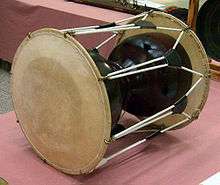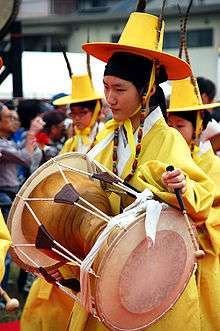Janggu
The janggu (or janggo; also spelled changgo) or sometimes called seyogo (slim waist drum) is the most representative drum in traditional Korean music.[1]. It is available in most kinds, and consists of an hourglass-shaped body with two heads made from animal skin. The two heads produce sounds of different pitch and timbre, which when played together are believed to represent the harmony of man and woman. Janggu [장구] is one of instruments of Samulnori [사물놀이]. Samulnori consists of Janggu, Buk [북], Jing [징] and kkwaenggwari [꽹과리]
| Janggu | |
 | |
| Korean name | |
|---|---|
| Hangul | 장고 or 장구 |
| Hanja | |
| Revised Romanization | janggo or janggu |
| McCune–Reischauer | changgo or changgu |
History
The first depiction of the instrument is on a bell belonging to the Silla (57 BC–935 AD) period and in a mural painting of the same period in Goguryeo (37 BC–668 AD) tomb.[2] The oldest Korean historical records about an hourglass-shaped drum may be traced to the reign of King Munjong (1047–1084) of Goryeo as a field instrument. The Goryeo-sa (1451), or History of Goryeo, in chapter 70, records twenty janggu as part of a gift of instruments to be used in royal banquet music from the Song Dynasty Emperor Huizong to the Goryeo Court in Gaeseong in 1114. This book represents the earliest appearance of the word janggu in a Korean source. Later in chapter 80, for the year 1076, the term janggu-opsa (one who plays or teaches the janggu) is used.
The janggu may have evolved from the yogo (Korean: 요고; Hanja: 腰鼓; literally "waist drum"), another similar but smaller Korean drum that is still in use today. The yogo is thought to have originated from the idakka, an Indian instrument introduced into Korea from India through China during the Silla (57 BC–935 AD) period. Evidence of the yogo was depicted on the mural paintings in the tomb of Jipanhyun of Goguryeo, and from the pictures at the Gameun Temple, the Relics of Buddha, made of bronze in the second year of King Mun (682) during the Unified Silla period. It was during the time of Goryeo that the size of the Janggu grew to its present-day standard.
Construction
It is made from a hollow, hourglass-shaped wooden body of either porcelain, tile, metal, wood, gourd, or tinned sheet. Popular choices are poplar and paulownia woods. However, paulownia is most popular because it is the lightest and the best resonating material, producing beautiful sounds.
Jorongmok is the round tube in the middle connecting the left and right side of the hourglass-shaped body. The size of the jorongmok determines the quality of the tone: the wider the tube, the deeper and huskier it sounds; the narrower the tube, the harder and snappier it sounds.
The two skin heads are lapped onto metal hoops placed over the open ends of the body and secured by rope counter-loops. The left head (book side) named gungpyeon is covered with a thick cowhide, horsehide, or deerskin to produce deep and low tones. The right side (chae side) named chaepyeon is covered with either dog skin or a lighter horsehide to produces higher tones.
There are two kinds of beating sticks (chae), namely gungchae and yeolchae. The gungchae is shaped like a mallet with a round head. The handle is made from bamboo root, boiled and straightened out and the head is made from hardwood such as birch or antler. Modern gungchae may also be made from plastic; this variety is normally used by beginning musicians. The yeolchae is always made from bamboo.
Playing

Janggu is used throughout traditional Korean instrumental music, such as court music(궁중음악), wind music(풍류음악), folk music(민속음악) and shamanistic music(무속음악), as well as traditional performing arts divisions such as vocal music and dance and Yeonhui(연희).
Nongak(Pungmul), which only plays percussion instruments, serves to make the rhythms of percussion music colorful by playing finely divided rhythms of the combined notes of several percussion instruments.[3]
Traditionally the janggu is played using yeolchae on the right hand high pitch area and uses the bare hand on the low pitch area. Such an example can be seen on pungmul players for a number of folk songs and shamanistic rituals. But today, it is common to see the use of gungchae and yeolchae together. 'Gungchae' is used to play the low pitch side. With yeolchae, you can make the sound 'dda(따)', and with gungchae sound 'gung(궁)'. When you use it at the same time, you can make the sound 'dung(덩)'.[4] Janggu can be played on the floor such as for traditional sanjo music or carried with a strap on the shoulder. The way performers carry the Janggu differs from person to person, from region to region and varies depending on his or her taste.
The janggu is usually classified as an accompanying instrument because of its flexible nature and its agility with complex rhythms. Since the performer can use his or her hands as well as sticks, various sounds and tempi, deep and full, soft and tender, and menacing sounds, and fast and slow beats, can be created to suit the mood of the audience. Using this capability, a dextrous performer can dance along moving his or her shoulders up and down and make the audience become carried away and dance along with him
See also
| Wikimedia Commons has media related to Janggu. |
- Hourglass drum
- Traditional Korean musical instruments
- Korean music
References
- "장구와 장단". National Gugak Center. Retrieved 26 April 2017.
- Yi, Yong-sik. Shaman Ritual Music in Korea. Jimoondang International. ISBN 9781931897105. Retrieved 25 March 2017.
- 국립민속박물관. "장고". 한국민속대백과사전 (in Korean). Retrieved 2019-03-22.
- 한국아동국악교육협회 (2013-04-03), 장구 기본장단, retrieved 2019-03-15
- Nathan, Hesselink (2006).P'ungmul: South Korean Drumming and Dance. University of Chicago Press.
Sound
This is the sound of the editor playing the janggu. This sound is the melody of 'Imsil Pilbong Nongak.'
- whee-mori(휘모리 : the meaning of being as fast as the whirlwind)
- Doen-samchae(된삼채 : It means to play the 'Samchae' fast)
- Slow-gaengigaeng (느린-갠지갱 : It means to play the'gaengigaeng' slow)
- Chae-gut (채굿 : Composed of six kinds of chae-gut)
- ilchae
- leechae
- samchae
- sachae
- yukchae
- chilchae